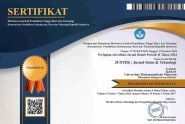A First-Principle study of the O, O2, OH, and HO2 adsorption on the Fe (100) surface
Abstract
Abstract: The purpose of this study was to investigate the interaction between O, O2, OH, and HO2 species on the Fe(100) surface using the DFT method. The DFT calculation provides specific information of the electronic structure of a molecules in ground state. The results show that the O atom preferred to be adsorbed on the hollow site, the OH species was adsorbed on the bridge site, while the O2 molecule was dissociated into two O atoms where both were adsorbed on the hollow site. Furthermore, when the H atom is attached to one of the O atoms of the dissociated O2 molecule, the OH species is formed which is adsorbed at the bridge site, and another O atom which remains adsorbed at the hollow site. This study can provide preliminary information on the adsorption mechanism of O, O2, OH, and HO2 species in explaining the electrochemical corrosion mechanism in our next work.
Abstrak: Penelitian ini bertujuan untuk mengetahui interaksi antara spesi O, O2, OH, dan HO2 pada permukaan Fe(100) menggunakan metode DFT. Perhitungan DFT memberikan informasi spesifik tentang struktur elektronik molekul dalam keadaan dasar. Hasil penelitian menunjukkan bahwa atom O lebih suka teradsorpsi pada situs berongga, spesi OH teradsorpsi pada situs jembatan, sedangkan molekul O2 terdisosiasi menjadi dua atom O dimana keduanya teradsorpsi pada situs berongga. Selanjutnya, ketika atom H terikat pada salah satu atom O dari molekul O2 terdisosiasi, terbentuk spesies OH yang teradsorpsi di situs jembatan, dan atom O lain yang tetap teradsorpsi di situs berongga. Penelitian ini dapat memberikan informasi awal tentang mekanisme adsorpsi spesi O, O2, OH, dan HO2 dalam menjelaskan mekanisme korosi elektrokimia pada penelitian kami selanjutnya.Keywords
Full Text:
PDFReferences
A.B. Anderson. (1981). Reactions and structures of water on clean and oxygen covered Pt (111) and Fe (100). Surface Science, 105 (1981) 159-176.
A. Kokalj, H. Behzadi, R. Farahati. (2020). DFT study of aqueous-phase adsorption of cysteine and penicillamine on Fe (110): Role of bond-breaking upon adsorption. Applied Surface Science, 514:145896, https://doi.org/10.1016/j.apsusc.2020.145896
A. Safakas, G. Bampos, S. Bebelis. (2019). Oxygen reduction reaction on La0.8Sr0.2CoxFe1-xO3-δ perovskite/carbon black electrocatalysts in alkaline medium. Applied Catalysis B: Environmental, 244:225–232, https://doi.org/10.1016/j.apcatb.2018.11.015.
B. Yang, K. Shi, H. Li, L. Jiang, C.H. Zhang. (2019). Water dissociative adsorption on the pre-covered Fe (100) surface from DFT computation. Indian J Phys., 93 (8) : 1019–1029, https://doi.org/10.1007/s12648-018-01372-9.
D. Vanderbilt. (1990). Soft self-consistent pseudopotentials in a generalized eigenvalue formalism. Phys. Rev. B, 41 : 7892–7895, https://doi.org/10.1103/PhysRevB.41.7892.
H.J. Monkhorst & J.D. Pack. (1976). Special points for Brillouin-zone integrations. Phys. Rev. B, 13 : 5188.
J.P. Lu, M.R. Albert, S.L. Bernasek. (1989). The adsorption of oxygen on Fe (100) surface. Surface Science. 215 (1989) 348-362.
J.P. Perdew, K. Burke, M. Ernzerhof. (1996). Generalized gradient approximation made simple. Phys. Rev. Lett., 77 (18) : 3865–3868, https://doi.org/10.1103/PhysRevLett.77.3865.
J. Stacy, Y.N. Regmi, B. Leonard, M. Fan. (2017). The recent progress and future of oxygen reduction reaction catalysis: A review. Renewable and Sustainable Energy Reviews, 69 (2017) 401-414, http://dx.doi.org/10.1016/j.rser.2016.09.135.
K.H. Chew, R. Kuwaharac, K. Ohno. (2018). First-principles study on the atomistic corrosion processes of iron. Phys.Chem.Chem.Phys., 20:1653, DOI: 10.1039/c7cp04022a.
M.F. Ng, D.J. Blackwood, H. Jin, T.L. Tan. (2020). DFT study of oxygen reduction reaction on chromia and hematite: insights into corrosion inhibition. J. Phys. Chem. C, 124 (2020) 13799-13808, https://dx.doi.org/10.1021/acs.jpcc.0c03559.
M. Reda, H.A. Hansen, T. Vegge. (2018). DFT study of the oxygen reduction reaction on carbon-coated iron and iron carbide. ACS Catalysis, DOI: 10.1021/acscatal.8b02167.
P. Błoński, A. Kiejna, J. Hafner. (2005). Theoretical study of oxygen adsorption at the Fe (110) and (100) surfaces. Surface Science, 590:88–100. DOI:10.1016/j.susc.2005.06.011.
P. Błoński, A. Kiejna, J. Hafner. (2008). Dissociative adsorption of O2 molecules on O-precovered Fe (110) and Fe (100): Density functional calculations. Physical Review B, 77 (2008) 155424, DOI:10.1103/PhysRevB.77.155424.
P. Giannozzi, O. Andreussi, T. Brumme, O. Bunau, M.B. Nardelli, M. Calandra, R. Car, C. Cavazzoni, D. Ceresoli, M. Cococcioni, N. Colonna, I. Carnimeo, A.D. Corso, S. de Gironcoli, P. Delugas, R. Di Stasio, A. Ferretti, A. Floris, G. Fratesi, G. Fugallo, R. Gebauer, U. Gerstmann, F. Giustino, T. Gorni, J. Jia, M. Kawamura , H.Y. Ko, A. Kokalj, E. Küçükbenli, M. Lazzeri, M. Marsili, N. Marzari, F. Mauri, N.L. Nguyen, H.V. Nguyen, A.O. de-la Roza, L. Paulatto, S. Poncé, D. Rocca, R. Sabatini, B. Santra, M. Schlipf, A.P. Seitsonen, A. Smogunov, I. Timrov, T. Thonhauser, P. Umari, N. Vast, X. Wu, S. Baroni. (2017). Advanced capabilities for materials modeling with Quantum Espresso. J. Phys: Condens. Matter, 29 : 465901, https://doi.org/10.1088/1361-648X/aa8f79.Rapp. (2006). An enormous breadth of engineering systems depend upon corrosion protection for their reliability, performance, and safety. Materials Today, 9.
R. Kohlhaas, P. Donner, N.S. Pranghe. (1967). The temperature-dependence of the lattice parameters of iron, cobalt, and nickel in the high temperature range. Z. Angew. Phys., 23 : 245.
T.H. Fischer. (1992). General methods for geometry and wave function optimization. J. Phys. Chem., 96 : 9768-9774.
Trethewey. (1988). Corrosion: for students of science and engineering. Longman Scientific & Technical.
W. Cao. (2010). Using and validation of the DFT method for oxygen adsorbed on the iron (100) surface, Mineral Processing and Extractive Metallurgy. Trans. Inst. Min Metall. C., 119 (2010) 67, DOI:10.1179 / 037195510X12665949176373.
W. Wang, G. Wang, M. Shao. (2016). First-principles modeling of direct versus oxygen-assisted water dissociation on Fe (100) surfaces. Catalysts. 6 (2016) 29, doi: 10.3390 / catal6020029.
Y. Sakisaka, T. Miyano, M. Onchi. (1984). Electron-energy-loss-spectroscopy study of oxygen chemisorption and initial oxidation of Fe (100). Physical Review B, 30.
Z. Chen, Y. Nonga, J. Chenb, Y. Chenb, B. Yua. (2020). A DFT study on corrosion mechanism of steel bar under water-oxygen interaction. Computational Materials Science, 171:109265, https://doi.org/10.1016/j.commatsci.2019.109265.
Z. Chen, Y. Nonga, Y. Chenb, J. Chenb, B. Yua. (2020). Study on the adsorption of OH- and CaOH+ on Fe (100) surface and their effect on passivation of steel bar: Experiments and DFT modelling. Corrosion Science, 174:108804, https://doi.org/10.1016/j.corsci.2020.108804.
DOI: https://doi.org/10.31764/justek.v4i2.5738
Refbacks
- There are currently no refbacks.
JUSTEK : Jurnal Sains dan Teknologi sudah terindeks
EDITORIAL OFFICE:












.JPG)

